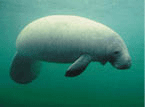

 Many years ago my wife and I rented a houseboat in Deland, Florida, and spent a delightful week exploring the inland waters around Deland. One of the places we visited was called Blue Springs. I knew about this area from my teaching, and when I told the boat owner that I wanted to go to Blue Springs, he said, “Oh, you want to see the ugly mermaids.” Stories about mermaids go way back in marine history to when men envisioned creatures with a beautiful woman's upper body and a fish's lower body. The name “manatee” comes from a pre-Columbian Caribbean people meaning “breast.” The boat owner warned me not to get into the water with these mermaids, and to be aware that they were very stupid.
Many years ago my wife and I rented a houseboat in Deland, Florida, and spent a delightful week exploring the inland waters around Deland. One of the places we visited was called Blue Springs. I knew about this area from my teaching, and when I told the boat owner that I wanted to go to Blue Springs, he said, “Oh, you want to see the ugly mermaids.” Stories about mermaids go way back in marine history to when men envisioned creatures with a beautiful woman's upper body and a fish's lower body. The name “manatee” comes from a pre-Columbian Caribbean people meaning “breast.” The boat owner warned me not to get into the water with these mermaids, and to be aware that they were very stupid.
Manatees live in many places around the world including Africa, the Amazon, and the West Indies. They can be 13 feet long and weigh 1,200 pounds. In spite of that large size, they have the smallest brain-to-body ratio of any mammal, and the brain is totally smooth, not folded with fissures. This led scientists in the past to assume the manatee was a very stupid animal. That conclusion is being challenged by modern research. Manatees are vegetarians, so they are used in some sea areas to keep vegetation out of water intakes and boat canals. Their teeth are made to grind up plant material. They have a simple stomach with a large cecum to digest tough plants. The animal has 45 meters (over 120 feet) of intestines to do its digesting, and it produces a great deal of gas in the process. The bone density of the manatee is very high allowing it to be submerged in the water easily. The manatee has 2,000 vibrissae (“whiskers”), which are specialized hairs on its face. Six-hundred of these are arranged in a circular region between the nose and mouth and are used to explore objects. There is some evidence these special structures are also used for navigation.
It is hard to imagine how sailors in the old days looked at this animal called “a sea cow” locally, and saw in it a beautiful woman. (That might depend on how long they had been at sea.) To a modern biologist, however, there are wonderful features of design to be studied that are unique to the manatee. Like everything we see in the world around us, we find wonderful engineering by God, carefully designed into all his creatures. Sources: The New York Times, August 29, 2006, page D1, and “manatee” on wikipedia.org.
Picture credits:
http://en.wikipedia.org/wiki/File:FL_fig04.jpg.
